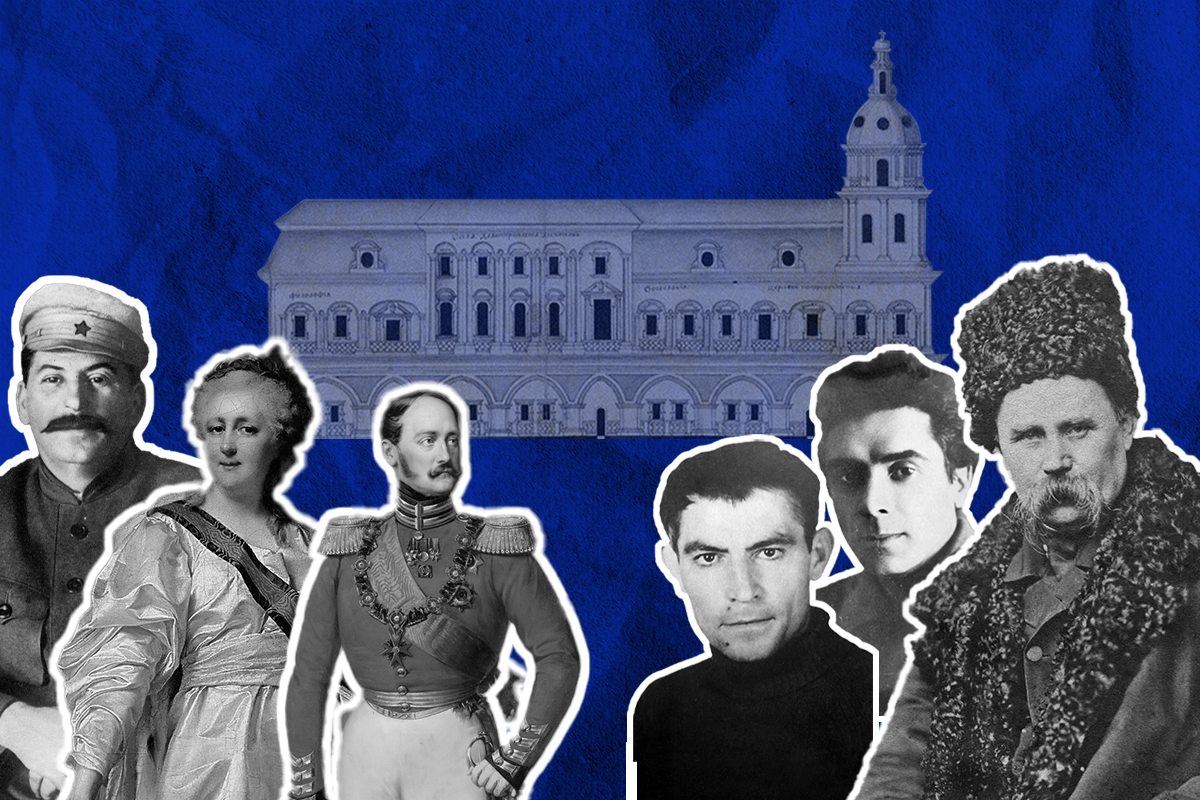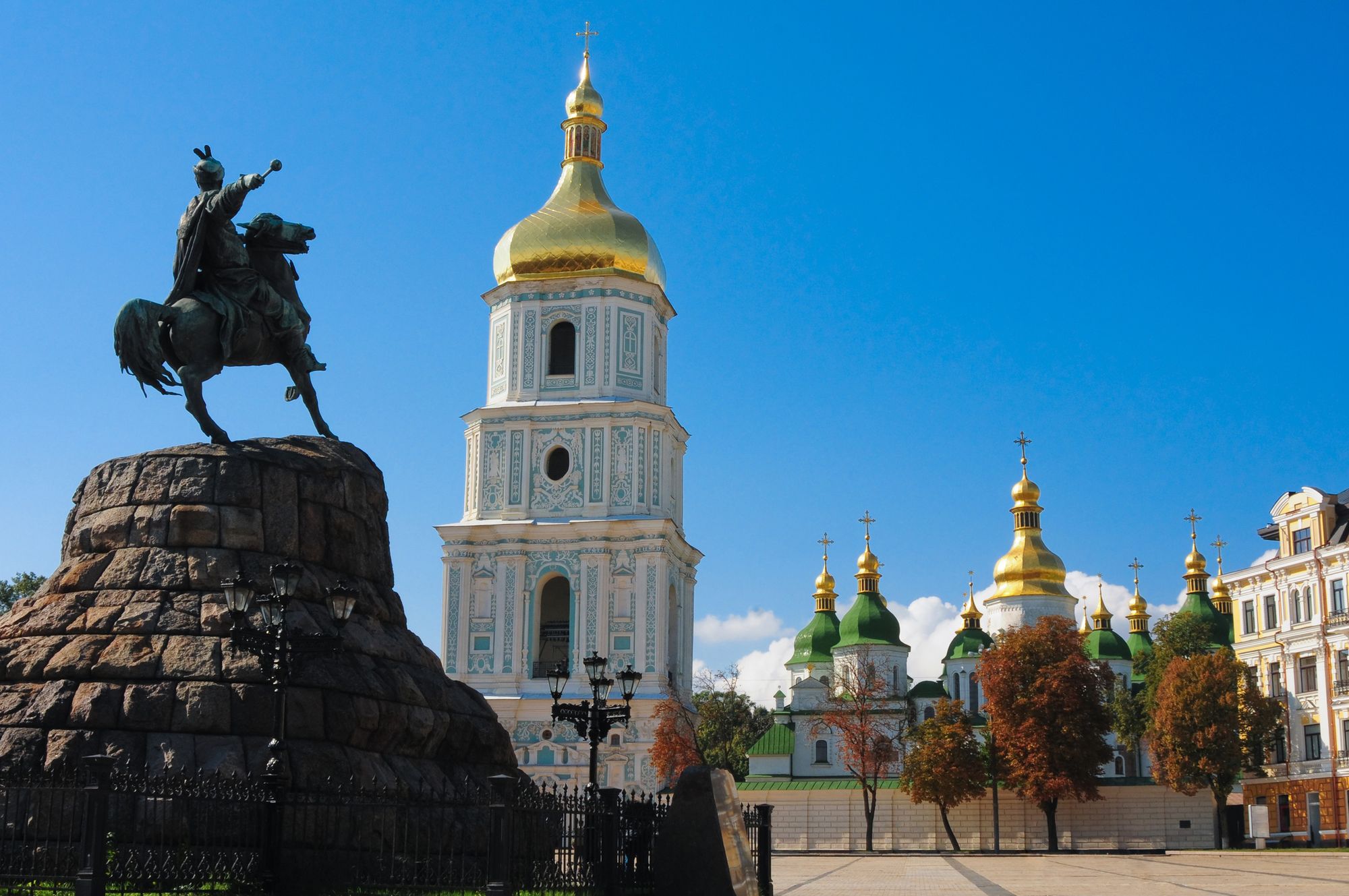Kyivan Rus was one of the most developed states of medieval Europe, lasting from around the late ninth to the mid-thirteenth century. It played a significant role in the history of the continent and the future East Slavic nations.
The territories of Kyivan Rus included much of modern-day Ukraine, Belarus, and western parts of Russia. Located in the center of trade routes, it was a link between Europe and the Arab East.
At its height in the mid-11th century, it stretched from the Baltic Sea to the northwest and the Black Sea to the south. Its center was Kyiv, Ukraine's modern-day capital.
Fueled by Russia's neo-imperial rhetoric, Russian President Vladimir Putin has portrayed Russia as the only successor to the medieval state, despite its center having been in Kyiv.
Russia has built its entire history through links to medieval Rus, the name of which it appropriated centuries after Kyivan Rus' demise. Historical work on Kyivan Rus also contributed to a misunderstanding of the state’s history.
According to historian Paul Magocsi, "For the longest time, English language writings did not distinguish the name Rus from Russia," resulting in the "conceptually distorted formulation Kyivan Russia.”
Kyivan Rus met its decline in the thirteenth century when the Mongols invaded and sacked Kyiv, creating a centuries-long gap between the medieval state and modern-day eastern European countries.
And while Kyivan Rus is certainly the first stage in the evolution of the modern Ukrainian, Belarusian, and Russian peoples, the early Slavic state encompassed a massive territory with many different people living under it, undermining any modern state's claim as its sole inheritor.
How did Kyivan Rus originate?
The origins of Rus and the foundation of Kyivan Rus have sparked a centuries-long debate that continues to this day.
Scholars have debated whether Kyivan Rus was created by the political self-organization of East Slavic tribes or if they invited outsiders, the Varangian Rus people (a group of Vikings) from Scandinavia, to come and create it for them.
Most of our knowledge of the period comes from the Primary Chronicle, written by the Kyivan monk Nestor at the beginning of the 12th century. Some of its details are questionable, having been written much later after the events.
The Primary Chronicle tells of the first of several powerful East Slavic tribes, most notably the Polianians. According to the Primary Chronicle, their chief, Kyi, built a town along with his brothers Shchek and Khoryv and sister Lybid in the fifth century and called it Kyiv.
According to the chronicle's version of events, around the mid-ninth century, groups of East Slavic and Finnic tribes, at the time vassals of the Varangians, had set out to rule themselves.
Failing to do so peacefully, they sent an invitation to Varangian Rus nobles to rule over their lands.

The Primary Chronicle says that upon receiving the invitation, the Rus' sent three brothers, Rurik, Sineus, and Truvor, to govern Staraya Ladoga (another chronicle calls it Novgorod), Beloozero, and Izborsk–all located in modern-day Russia. After his brothers' deaths, Rurik moved to Novgorod.
As the story goes, two of Rurik's boyars, Askold and Dir, were sent to Constantinople and, on their way, stopped in Kyiv. Along with other Varangians, they managed to establish control over the city.
In the late ninth century, the new Varangian ruler of Novgorod, Oleh, came to Kyiv, killed Askold and Dir, and united the northern and southern lands, proclaiming Kyiv the capital and the mother of Rus cities, thus establishing the state that would later come to be known as Kyivan Rus.
"Although one can and should question many details of (the Primary Chronicle)...the legend probably echoes the actual consolidation of power by one group of Vikings in the forested regions of eastern Europe between present-day Velikii Novgorod and Kyiv," Harvard historian Serhii Plokhy points out in his book on Ukrainian history titled The Gates of Europe.
Who are the key figures of Kyivan Rus?
In addition to Oleh (also referred to as Helgi), the growth and expansion of Kyivan Rus in its first two centuries are associated with his three successors, Ihor, Olha, and Sviatoslav, as well as subsequent rulers who developed Kyivan Rus lands and carried out several reforms.
Olha of Kyiv, who reigned from 945-962, was the only woman to rule Kyivan Rus and is widely known for her supposed harsh revenge on the Drevlians tribe, the tribe that assassinated her husband Ihor.
Revolts against extortive tax collection practices had become commonplace (the Drevlians having likely revolted for this very reason), leading Olha to improve tax collection practices through the introduction of pogosti, or administrative centers, that organized tax payments locally as opposed to by central authorities.
She was also the first member of the ruling family to convert to Byzantine-rite Christianity and is perhaps best known for improving Byzantine-Rus relations.
The "Golden Age" of Kyivan Rus is marked by the reigns of Volodymyr the Great and Yaroslav the Wise. During his reign, which lasted from 980 to 1015, Volodymyr expanded the borders and merged the remaining East Slavic tribes that were still not under Kyivan Rus' rule.
He also changed the administrative system of the state by dividing the land and assigning his sons to rule as local princes, subordinating them to the prince of Kyiv and ending tribal autonomy.
To unify tribes and consolidate his power, Volodymyr also carried out a religious reform – he accepted Byzantine-rite Christianity and allegedly ordered the baptizing of his subjects in the Dnipro River. Following the reform, he began building Orthodox churches, including the Church of the Tithes in Kyiv, which was destroyed several times throughout its history and never rebuilt.
Volodymyr's baptism, however, has been the source of great controversy, with disagreement among scholars as to why Volodymyr accepted Christianity and when exactly the baptism occurred.
According to some historians, Volodymyr may have already been baptized and agreed to be re-baptized in order to please the Byzantine emperor.
Volodymyr's son, Yaroslav the Wise, followed in his father's footsteps and continued to increase Kyiv's significance by erecting many landmarks, including the Golden Gate of Kyiv and the Saint Sophia Cathedral, the center of church-state politics and cultural life of Kyivan Rus.

Yaroslav ruled Kyivan Rus from 1019 until his death in 1054.
Yaroslav also focused on strengthening European ties through marital diplomacy. His daughters were married to the kings of France, Norway, and Hungary, while his sons married a princess of Poland, the sister of the bishop of Trier in Germany, and a Byzantine princess.
Yaroslav is remembered not only for his diplomacy and architectural treasures but also for his desire to implement political unity. He created a legal code called the Ruska Pravda (Rus Truth) and rules of political succession, ordering future sons to respect the authority of the Kyivan prince.
How did Kyivan Rus meet its end?
Constant conflicts between local princes left Kyivan Rus vulnerable to foreign attacks. In 1240, the Mongols managed to capture and practically destroy the city, precipitating what is considered to be the end of Kyivan Rus.
During the invasion of Batu Khan in 1240, Kyiv was part of the Halych-Volhynia principality ruled by Danylo Halytskyi, who had captured the city in 1239.
While the Kyivan Rus state ceased to exist as such, local princes were largely allowed to continue to rule over their patrimonies if they recognized the authority of the Mongols and paid tribute. This generally preserved the political and socioeconomic structure of Kyivan Rus, according to scholars.
The fragmentation of Kyivan Rus following the Mongol invasion gave rise to three powerful independent states: Halych-Volhynia, located in central and western parts of modern Ukraine, and Vladimir-Suzdal and Novgorod, both located primarily in what is now Russia.

Danylo Halytskyi, the ruler of the Halych-Volhynia principality, resisted the Mongols and tried to build opposition seeking Western support from Hungary, Poland, and Lithuania. He also requested support from Pope Innocent IV, who later sent a delegation that crowned Danylo Halytskyi as the King of Rus.
Halych-Volhynia and Vladimir-Suzdal both claimed the name Rus for the lands they now ruled over but followed very different paths. The intermingling of different populations, social changes, and distinct politics transformed society and formed two separate states with their own characteristics.
Halych-Volhynia was integrated into European affairs and was eventually divided between Poland and a new rising power – the Grand Duchy of Lithuania. The latter was also able to conquer Kyiv in 1362, over 100 years after it fell to the Mongols.
Meanwhile, Mongols ruled over parts of what is now Russia for nearly 200 years, during which time Moscow was founded by Yuriy Dolgorukyi around 1147 and rose from being a small settlement in the Vladimir-Suzdal principality to a center of power and key vassal of the Golden Horde.
During this time, old East Slavic languages, already considered to be distinct, officially split into two branches – Ruthenian (West Rus language) became the official language in Lithuania, and Old East Slavic became standardized in the Grand Duchy of Moscow.
Ukrainian and Belarusian languages are believed to derive from Ruthenian, while Russian evolved from the Old East Slavic.
How has Russia distorted the history of Kyivan Rus?
From the mid-15th century, the Grand Duchy of Moscow set its eye on expanding its borders. Moscow's new ideology would center around the fact that all the territories once part of Kyivan Rus needed to be gathered into one.
In 1547, Ivan IV of Moscow, known later as Ivan the Terrible, was crowned Tsar of all Rus, despite having no control over most of the former Kyivan Rus principalities that became a part of the Grand Duchy of Lithuania. The name Tsardom of Russia became interchangeable with that of the Tsardom of Muscovy.
On Oct. 22, 1721, Russian Tsar Peter officially changed the country's name from the Tsardom of Russia to the Russian Empire, thus fully appropriating the name of Kyivan Rus and shaping its imperial identity. He also proclaimed himself as the emperor of all of Russia.

A couple of decades later, Catherine the Great would see an urgent need to write a new version of Russian history, fueled by the rapid expansion of the Russian Empire during her reign.
On Dec. 4, 1783, Catherine issued an order to set up a "Commission for making notes about ancient history, mostly of Russia," which was tasked with fulfilling her vision of history. This version effectively proclaimed the Russian Empire as the successor to Kyivan Rus.
Six months before Russia’s full-scale invasion of Ukraine in February 2022, Russian President Vladimir Putin published an article calling Ukrainians and Russians the offsprings of "ancient Russian statehood," distorting history and claiming Russia as the only heir of Kyivan Rus.
In fact, Putin didn’t even mention the name Kyivan Rus in his essay, instead referring to it as Ancient Rus.
Russia has also sought to purge its own national history of the links between modern-day Ukraine and Kyivan Rus, despite an obvious historical relationship between the two.
One month after the start of Russia's all-out war against Ukraine, Russian independent media outlet Mediazona reported that employees of the Prosveshcheniye group, Russia's largest educational publisher, were urged to reduce and sometimes even omit references to Ukraine and Kyiv from all school textbooks, including ones that make connections between Ukraine and Kyivan Rus.
In attempting to create historical continuity between modern-day Russia and Kyivan Rus, Russia has sought to legitimize its right to rule over Ukrainian lands and justify its aggression against Ukraine.













